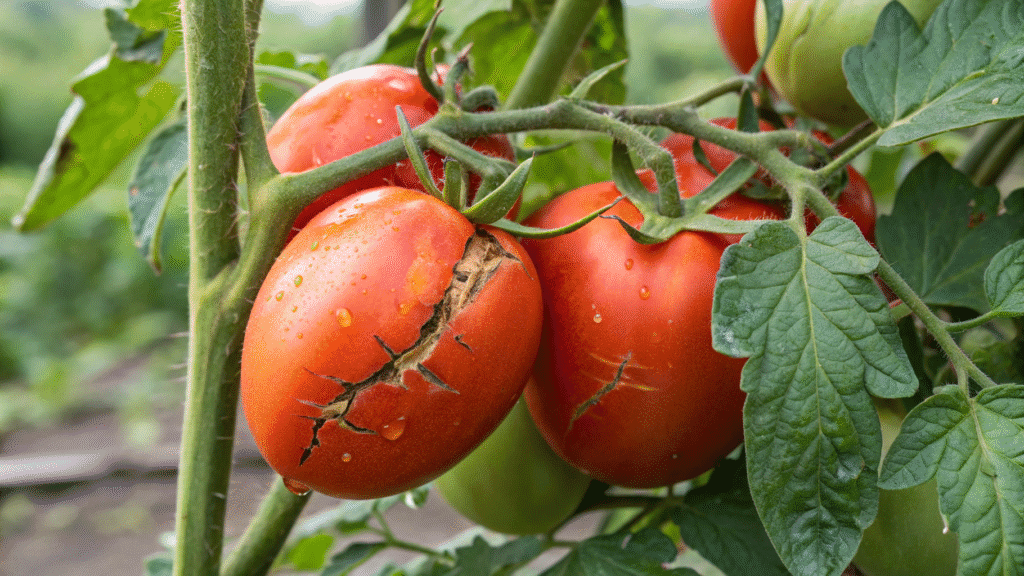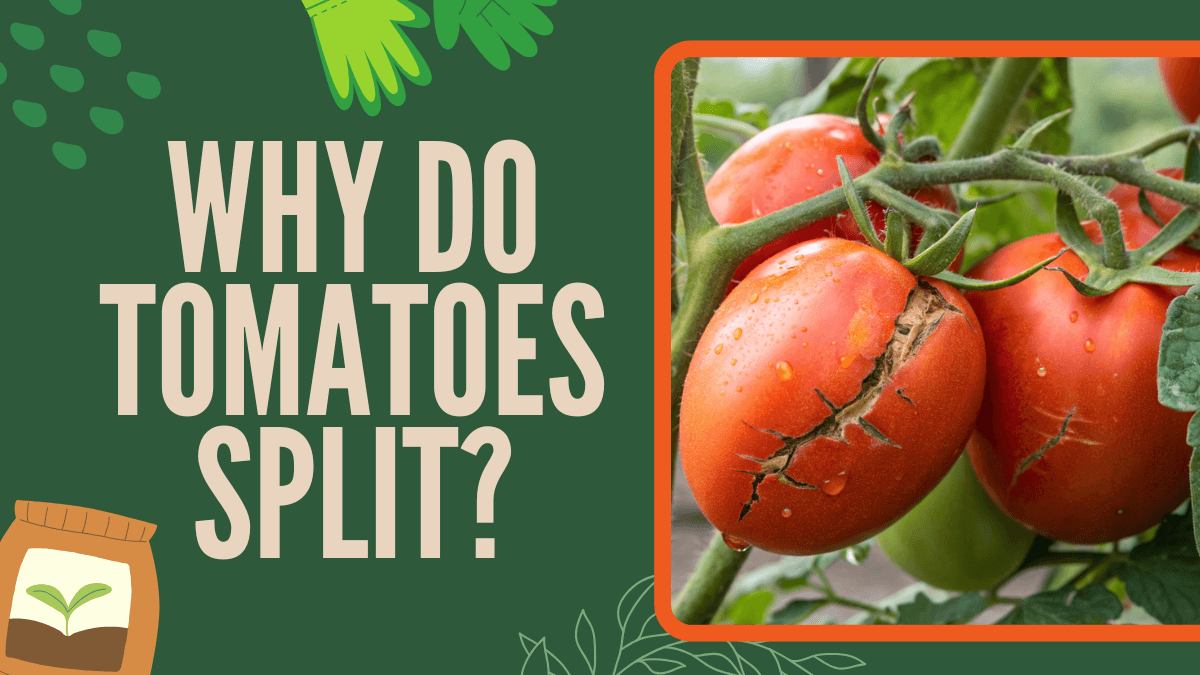Have you ever stepped into your garden, dreaming of a perfect tomato harvest, only to find your ripe beauties cracked and split? It’s a punch to the gut, isn’t it?
I’ve been there, watching my hard work literally burst at the seams. But here’s the good news: understanding why do tomatoes split can save your crop and your sanity. Whether you’re growing juicy cherry tomatoes or hefty beefsteaks, splitting is a common hiccup.
I’ll dig into the causes, explore prevention tricks, and answer questions like “Can you eat split tomatoes?” Stick with me, and let’s turn those cracked tomatoes into a thing of the past!
Table of Contents
Why Do Tomatoes Split?
So, why do tomatoes split? It’s all about pressure—inside the fruit, that is. The main culprit? Inconsistent watering. Picture this: your tomatoes are chugging along, soaking up just enough water to grow. Then, bam—a dry spell hits, followed by a heavy rain or an overzealous watering session. The fruit’s insides swell faster than the skin can stretch, and crack—you’ve got a split tomato.

Here’s what’s usually behind it:
- Water: Too little water, then too much, makes the fruit expand rapidly.
- Rain: A downpour after drought-like conditions is a recipe for splitting.
- Hot and Cold Swings: Temperature changes stress the skin, especially if it’s already tight.
- Thin-Skinned Suspects: Some varieties, like cherry tomatoes, split more easily.
Ever wondered why cherry tomatoes split more often? Their delicate, thin skins can’t handle sudden growth spurts as well as thicker-skinned varieties. And what about green tomatoes splitting? That happens when they’re still developing and hit with a water surge. Knowing these triggers is step one to keeping your harvest intact.
Cracks and Splits: The Different Types You’ll See
Not all tomato splits look the same, and the type of crack can clue you in on what’s going wrong. Here are the two big players:
- Radial Splitting: Long, vertical cracks running from the stem down the side. These scream “too much water, too fast!” Think of it like a balloon popping from overinflation.
- Concentric Splitting: Circular cracks around the stem—like a bullseye. These often pop up when temperatures bounce around or water gets excessive.
Noticed tomatoes splitting on top? That’s usually concentric cracking at work, triggered by weather whiplash. And if you’re seeing tomatoes splitting before ripening, it’s likely the same deal—rapid growth outpacing the skin’s stretch. Recognizing these patterns helps you troubleshoot and tweak your care routine.
Can You Eat Split Tomatoes?
The short answer? Yes, usually! If the split is fresh—no mold, no funky smells, no bugs—you’re good to go. Just grab a knife, slice away the cracked bit, and enjoy the rest. I’ve salvaged plenty of split tomatoes for salsa or sauce this way.
But if the split’s been sitting for a while, things can get dicey. Rot can set in, or pests might move into the gap. If it looks or smells off, toss it. Better safe than sorry, right?
Tip: Harvest split tomatoes ASAP to stop further damage. Trust me, it’s worth the effort to save what you can.
5 Ways to Stop Tomato Splitting Before It Starts
Now that we know why tomatoes crack, let’s talk prevention. It’s just a little consistency and planning.

Here’s how to keep your tomatoes whole and happy:
- Water at the Right Time: Aim for 1-2 inches of water 2-3 times per week, adjusted for rain. Use a soaker hose or drip irrigation for steady moisture.
- Mulch It Up: Lay down straw, wood chips, or grass clippings around plants to lock in soil moisture and buffer against dry spells.
- Pick Smart Varieties: Go for crack-resistant types like ‘Juliet,’ ‘Celebrity,’ or ‘Big Beef.’ They’re tougher than they look!
- Beat the Rain: If a storm’s coming, harvest tomatoes that are close to ripe. They’ll finish ripening indoors, no cracks required.
- Shade Them: Use a shade cloth during heat waves to ease temperature stress.
Mistakes That’ll Crack Your Tomatoes (and How to Avoid Them)
Even seasoned gardeners slip up sometimes. Here are some common goofs that lead to splitting—and how to dodge them:
- Overwatering: Dumping too much water at once is just as bad as forgetting to water. Stick to a schedule instead of guessing.
- Soil Neglect: Poor drainage or compacted soil traps water, stressing roots and fruit. Mix in compost to keep things loose and healthy.
- Weather: Ignoring a forecast can leave you scrambling. A quick peek at your weather app can save your crop.
It’s a bummer when your tomatoes split, but honestly, we’ve all been there. I once overwatered my plants, thinking I was “helping” after a dry week. The cracks taught me to chill out and trust the process.
When to Pick Tomatoes to Avoid the Split
Timing is everything. Harvesting at the right moment can stop splitting in its tracks.

Here’s the game plan:
- Grab Them Early: Pick tomatoes when they’re just turning color—pink or light red—if rain’s on the horizon. They’ll ripen indoors on a windowsill.
- Daily Checks: During peak season, walk through your garden daily. Ripe or near-ripe fruit won’t split if you get to them first.
- Gentle Hands: Handle tomatoes carefully—bruised skin splits more easily.
Tomatoes splitting before ripe often happens because they’re left on the vine too long during unpredictable weather.
Wrapping It Up: Crack-Free Tomatoes Are Within Reach
Tomato splitting might feel like a gardening curse, but it’s totally manageable. By keeping water steady, choosing hardy varieties, and timing your harvest, you can cut down on cracks and enjoy more of your crop.
Why do tomatoes split? It’s all about balance—water, weather, and a little TLC. Try these tips next season, and let me know how it goes in the comments.
Bonus: If you are interested in gardening, read my article “Organic Vegetable Gardening for Beginners“


 ChatGPT
ChatGPT
 Perplexity
Perplexity
 Claude
Claude
Leave a Reply